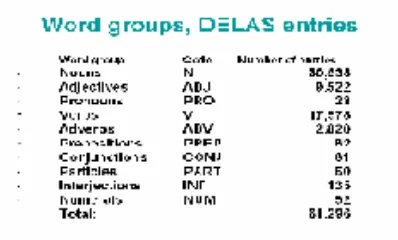attributes (84 for the Macedonian language) and their values (134). The morpho-syntactic description is represented as a string of different characters. The word forms were semi-automatically classified: 60% automatically according to the inflection and the rest of the words manual. Each word is also associated with its lemma. This annotated corpus was used for learning of the TnT (Trigrams’n’Tags) which is an efficient language-non-specific statistical part-of-speech tagger suitable for training on large corpora. The tagger tested on the same corpus achieved an accuracy of 98.1%. The further work of this research group regards the finalization of the lexical lists through a rule-based lexicon, re-learning of the tagger and its testing on another text.
3.
Electronic dictionaries
3.1 Intex/Nooj electronic dictionary of simple words
The second part of this paper will focus on the compilation of two electronic dictionaries. Aleksandar Petrovski is developing an electronic dictionary of simple words which is a starting point for the creation of the Macedonian module in the frame of the Intex, recently Nooj corpus processing system. (Petrovski, 2005; Silberztein, 2005) One of the main aims of Intex/Nooj is to allow the construction of formalized description of languages and apply them to large corpora compiled acoording to the needs of the user. The main linguistic resources of this development environment are the e-morpho-syntactical dictionaries and various types of grammars (inflectional, derivational, lexical, orthographical, syntactic, semantic etc.) represented as a set of graphs. Finite-state automata, finite-state transducers and other computational devices are used for the formalization of the linguistic phenomena. The system works through language-specific modules developed by several teams of researchers that can be upgraded and modified by the user. The level of elaboration of the module differs from language to language.
The core of each language module are the e-dictionaries that are conformed to the methodology promoted by the RELEX network: the first step is the creation of the dictionary of lemmas and corresponding flectional codes (DELAS) in order to automatically build the dictionary of all inflected forms (DELAF). Petrovski has started working on the Macedonian DELAS presented at the 8th Nooj workshop:
Figure 1. Table of the word groups, the categories and the codes (Petrovski, 2005)
The main source used for the creation of the lexical database was the Blaze Koneski’s traditional dictionary of the Macedonian language. The dictionary was scanned and the errors were corrected. The basic tag set presented in Figure.1 is formed of 10 grammatical categories represented with corresponding codes. Each grammatical category is further described with certain number of attributes and values (ex. the nouns are represented with four attributes: gender with three values, number with four, case with three and definiteness with three values) At the moment of the presentation of the paper, the Macedonian DELAS consisted of 61.296 lemmas which produce 426.161 inflected forms as shown in Figure.2:
Figure 2: The total number of DELAS and DELAF entries (Petrovski, 2005)
Future activities are related to the compilation of the electronic dictionary of compound words (DELACF) and set of local grammars that can be used for disambiguation when a text is being processed. Furthermore, the Macedonian module should be adapted to the new version of the system called Nooj (Silberztein, 2005) which presents several differences when compared to Intex especially the organization and the compilation of the dictionaries. The basic feature of the Nooj dictionaries is the absence of the dictionary of inflected forms DELAF and the co-existence of both simple and compound words in a same dictionary. Some of the other main innovations in Nooj are: processing corpora rather than single texts, processing of more than 100 file formats which makes the system quite flexible and easy-for-use etc.
The development of a rich Macedonian module for Nooj will allow the linguists to use Nooj for processing of Macedonian corpora as well as a tool for extraction of terminology etc.
http://msh.univ-fcomte.fr/intex/downloads/Manual.pdf Silberztein, M. (2005) Nooj
http://perso.wanadoo.fr/rosavram/NooJ%20Manual.pdf Venovska-Antevska S. (2005). Makedonski jazicen
korpus. Ideja, moznosti, realizacija. In Predavanja na XXXVII seminar za makedonski jazik, literatura i kultura. Skopje: UKIM, Megunaroden seminar za makedonski jazik, literatura i kultura. pp. 77-92.
Vojnovski, V., S. Dzeroski and T. Erjavec, (2005) Learning POS Tagging from a Tagged Macedonian Text Corpus. In Proceedings of SIKDD 2005, Ljubljana, 2005. In press.
Zdravkova, K., A. Ivanovska, S. Dzeroski and T. Erjavec, (2005) Learning Rules for Morphological Analysis and Synthesis of Macedonian Nouns. In Proceedings of

